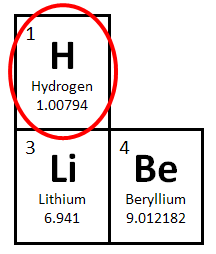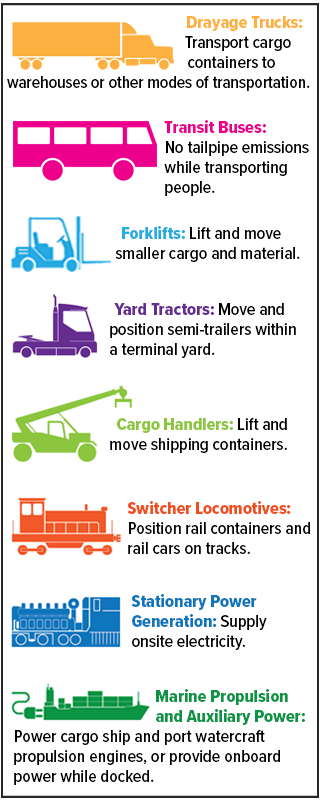Hydrogen in Transportation
E-Updates

Most fuel cell electric vehicles (FCEVs) are powered by hydrogen (H2) and considered zero-emission vehicles (ZEVs). FCEVs are like battery electric vehicles (BEVs) in that they are both electric vehicles (EVs) that use an electric motor instead of an internal combustion engine to power the wheels. However, while BEVs run on batteries that are plugged in to recharge, FCEVs produce their electricity onboard. Hydrogen can be used as fuel in a variety of fuel cell electric applications to generate power, emitting only water and heat as byproducts. The conversion of hydrogen to electricity emits no pollutants that affect public health and minimizes greenhouse gases (GHG) that contribute to climate change.
Hydrogen Today
Hydrogen has the potential to meaningfully reduce GHG emissions in the transportation sector. It can offer benefits to the heavy-duty transportation sector applications (i.e., long-haul trucks, locomotives, ships, etc.) where current battery technology might not yet be suitable for certain transportation modes (e.g., the necessary battery weight would be too substantial). Hydrogen can also store energy for long periods of time. As additional renewable electricity from wind and solar technologies is added to the grid, hydrogen could be used to help balance intermittent supply with varying demand. Integrating fueling infrastructure for hydrogen into our local and national roadways, similar to what was done with traditional fueling stations and is currently underway for BEV charging stations, will take some time.
Globally, there is a lot of interest in hydrogen as a low- and zero-carbon fuel option. Hydrogen is abundant in the universe and is a highly versatile energy carrier. It can be produced from many domestic resources and has a high energy content by weight. It is also extremely light, so it needs to be compressed or liquified, which can make it challenging and expensive to transport, store, and use. As hydrogen scales up across the economy, the costs are expected to continue to drop and become more competitive with other sources of energy.
Learn more about DOE’s H2@Scale Initiative.
Read responses to FAQs and common concerns regarding clean hydrogen.
Emissions
Like BEVs, FCEVs are considered zero-emission vehicles – they have no smog-related or GHG tailpipe emissions. However, some emissions can still be generated in the process of producing, transporting, and dispensing hydrogen fuel.
While hydrogen is abundant in the universe, it must be separated from other compounds to be used as fuel. This process can be energy intensive. The quantity of emissions associated with producing hydrogen fuels depends on the source of feedstock and method of production. Currently, almost all hydrogen in the U.S. is derived from natural gas by stripping and recombining hydrogen molecules from methane and water in a process called steam methane reforming. This process is well established but also energy intensive and results in carbon dioxide (CO2) emissions to the atmosphere if they are not captured and sequestered, and methane (CH4) emissions due to leakage throughout the natural gas supply chain. However, there are EPA efforts to reduce CH4 emission, in particular in the Inflation Reduction Act of 2022, where $1.55 billion will fund the Methane Emissions and Waste Reduction Incentive Program.
Another commonly used process for producing hydrogen is electrolysis, which involves running an electrical current through water to split the hydrogen from the oxygen. If this electricity comes from non-emitting source (e.g., solar photovoltaic, wind turbines, or hydropower), there are no upstream GHG emissions. If CO2 associated with the electricity used to produce hydrogen can be captured and stored, then hydrogen may still be produced with relatively few GHG emissions.
Hydrogen also can be made from plant materials. It can even be produced from your trash. Pilot projects have used landfill gas and wastewater to make hydrogen fuel. Check out What if Garbage Fumes Powered More of Our Cars, Trucks, and Buses? for more details.

Learn about the different ways to produce hydrogen fuel.
Learn more about the emissions from hydrogen production.
Learn more about clean hydrogen (pdf) (226 KB, October 2024).
Safety
Hydrogen is a small molecule that is flammable and has the potential to leak. However, hydrogen leak detection methods are in place to prevent leaks into the atmosphere. Furthermore, the storage tanks undergo rigorous testing where they must function properly at a rate that is double the pressure of what would be applied during normal use. The carbon fiber material used to make storage tanks is stronger than steel. And to provide even more assurance, all storage tanks must have a backup safety system in place.
Hydrogen Fuel Cell Vehicles in Action
A few examples of hydrogen being used in the real world:

- There are more than 50,000 hydrogen fuel cell electric forklifts already operating across the country1. These forklifts can be refueled in minutes and require less maintenance, which is why many major retailers around the country are using them to enhance warehouse productivity.
- The Alameda-Contra Costa Transit District (AC Transit) is the largest public bus-only transit agency in California. Their Zero Emission Bus Program has expanded from a single hydrogen fuel-cell electric bus to a fleet of thirty-six (36) 40-foot fuel-cell electric transit buses, plus several battery electric buses. AC Transit’s ZEB infrastructure includes on-site hydrogen production and fueling, on-site fleet maintenance, and workforce training. Their switch to zero emission buses has generated over 5 million miles and eliminated over 12,800 metric tons of CO2.2
As hydrogen fuel cell technologies expand, a sector that could greatly benefit is seaports. Replacing diesel engines across a variety of port applications can significantly reduce air pollutants associated with diesel emissions. Many other fuel cell applications are under development, including for port drayage trucks, yard tractors, cargo handlers (top loaders), switcher locomotives, and marine vessels such as harbor craft. 3 See EPA’s Ports Initiative Assessment of Fuel Technologies at Ports to learn more.
Learn more about hydrogen fuel cell technology
[1]2022 AMR Plenary Session (pdf) (9.9 MB, June 2022); Hydrogen and Fuel Cell Technologies Office; U.S. Department of Energy
[2]Zero Emission Transit Bus Technology Analysis, Volume 3 (pdf) (5.5 MB, June 2022); AC Transit Zero Emission Program
[3]Assessment of Fuel Cell Technologies at Ports (pdf) (3.6 MB, July 2022, EPA-420-R-22-013); Office of Transportation and Air Quality, U.S. Environmental Protection Agency

